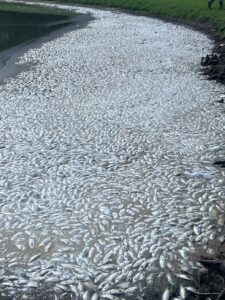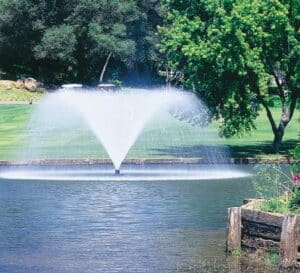Fish kills in urban ponds are more common than you might think. We field numerous calls every year regarding dead fish. The number of calls increases significantly during extremely hot and dry weather. So what causes fish to die and what can you do to minimize the risk?
When people see dead fish floating in their pond, they immediately think a foreign, toxic substance has made its way into the pond. While that is possible, it is actually the least common cause of fish kills. The vast majority of fish kills are caused by natural processes that interrupt dissolved oxygen levels. Dissolved oxygen is critical for the survival of all organisms with gills. These include fish, mollusks, tadpoles, and aquatic insects.

Oxygen Related Fish Kill
When can dissolved oxygen levels drop and cause fish to die?
There is a critical relationship between water temperature and its ability to hold oxygen. Cold water is typically saturated with oxygen; while warm water readily loses oxygen. As a result, fish kills due to natural causes are most common in July, August, and September.
Under normal conditions, most ponds have enough oxygen to support aquatic life. During the day, phytoplankton and aquatic plants use sunlight to produce oxygen through photosynthesis. Natural wind and wave action also adds oxygen to the water. However, oxygen production stops at night while the fish continue to consume oxygen. Therefore, dissolved oxygen levels are lowest in the early morning. It only takes a few minutes of oxygen stress to have a negative impact on fish populations. Overcast days do not allow oxygen levels to rebound. A single cloudy day during the summer may be just enough to cause a fish kill.
During Texas heat waves, ponds are often riding a fine line between “just enough” oxygen and levels below the critical threshold for fish survival. There are several factors that may tip the pond towards an oxygen depletion.
- Floating aquatic plants can block sunlight penetration and restrict oxygen production in the water column below.
- Muddy or “turbid” water will limit oxygen production.
- The decomposition of dying algae or plants can strip the water of valuable oxygen.
- Urban flooding can wash in organic material such as grass or leaves that decompose in the water column; resulting in an oxygen crash.
- Overstocking and failure to regularly harvest fish from small ponds is a prescription for eventual fish kills!
Extreme Heat Alone Can Kill Fish

Local Fish Kill Makes the News
Community storm-water ponds are often very shallow due to years of sediment accumulation on the bottom. Shallow ponds heat up quickly and offer the fish no escapement to deeper, cooler water. Combine that with elevated temperatures and dropping water levels and you have a recipe for disaster. Desirable fish can become stressed and start to die when water temperatures exceed 90 degrees.
What is a Pond Turnover?
Pond turnovers account for most of the fish kills here in north Texas. During the summer, a warm layer of oxygen rich water sits on top of cooler, oxygen deprived water. These layers do not mix due to their differences in temperature and density. This natural occurrence is called “stratification”.
When the stratified layers are disrupted, oxygen deprived water is forced to the surface along with decaying organic matter. This dilutes the oxygen and leaves fish with a deficit to support normal metabolism. Pond turnovers usually result in dark, coffee colored water with a septic odor. If your pond rapidly changes color, then a fish kill is likely to occur.
Pond turnovers happen in all ponds that are deep enough to stratify. Most turnovers are caused by the gradual cooling of the water surface in the fall. This type of turnover happens slowly and typically will not kill fish. However, rapid turnovers caused by cool, heavy rain are almost always catastrophic. Most of our fish kills here in north Texas occur the morning after a brief, heavy thunderstorm that was preceded by an extended period of heat and drought.
How Can You Minimize the Risk of an Oxygen Depletion?

Surface Aeration
There is no foolproof defense against an oxygen related fish kill. However, several things can be done to favor a healthy pond with good water quality.
- Supplemental aeration is your best insurance. Surface fountains that move a lot of water are best for the fish during periods of reduced oxygen (extreme heat, drought, excessive algae growth). Bottom diffused aeration is best for preventing pond turnovers.
- If the pond already has aeration, consider operating the unit 24/7 during periods of hot, dry weather. At a minimum, the unit should be set to come on 1 hour before sunrise.
- Limit the use of landscape fertilizer around the pond and in areas that drain directly to the pond.
- Bag all grass clippings and fallen leaves in the community.
- Avoid feeding waterfowl such as ducks and geese.
- Do not eliminate all aquatic weeds. Leave desirable plants in moderation for nutrient uptake and oxygen production.
- Tolerate some degree of algae and/or weed growth during extended periods of hot weather.
- Avoid fish overpopulation by allowing harvest. “Catch-and-Release” is NOT recommended in small, community lakes and ponds.
- Consider performing a sediment survey to quantify and monitor organic silt accumulation in the pond.
Chlorine is Highly Toxic to Fish!
We respond to several calls each year regarding fish kills due to water main breaks, fire hydrant flushing, and improper pool draining. City water contains chlorine in concentrations ranging from 0.5 to 2.0 ppm. Chlorine is highly toxic to fish and typically causes 100% kills at concentrations greater than 0.25 ppm. A sure sign of chlorine contamination is a sudden milky/cloudy appearance to the water due to chlorine killing beneficial phytoplankton in the water column. Once city water has entered the pond, there is little that can be done to reverse the toxic effects. Chlorine breaks down rapidly in the presence of sunlight; therefore, any amount of chlorine detected in surface water indicates recent chlorine toxicity. The good news is that there are no long-term effects and the pond can be re-stocked within weeks if the source of chlorine has been addressed.
My Fish Died, What are the Next Steps?
It is advised to let predatory wildlife clean up the dead fish. With the help of birds, turtles, and other critters, a fish kill will typically be cleaned up in a matter of days. Most oxygen related fish kills are only partial. For example, the large fish will die while the smaller ones are usually spared. The disturbance caused by trying to remove large, decomposing fish releases more decaying matter into the water. This can worsen the situation and potentially cause a catastrophic die off of all species and sizes of fish. Fish kills are always accompanied by bad smells. Commercially available oxidizing agents that are EPA approved for use in water can be applied to the water to minimize odors and kill any potential bacteria associated with the decomposing fish.
